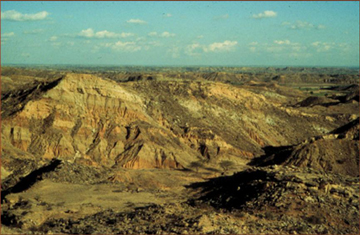
Geotimes Home | AGI Home | Information Services | Geoscience Education | Public Policy | Programs | Publications | Careers

Paleontologists suggested some new twists on tectonics and ecosystems at the
annual meeting of the Society of Vertebrate Paleontology (SVP), held mid-October
in St. Paul, Minn. Their ideas might offer answers to some key conundrums regarding
extinction, speciation and the global distribution of vertebrate species. (For
the full story online, read the WebExtra.)
Malcolm McKenna, a paleobiologist affiliated with the University of Wyoming
and the University of Colorado Museum, presented his ideas on the so-called
Lake Arctica scenario, when a proto-Iceland connected North America to Europe,
56 million years ago. “Everybody has assumed the only bridge connecting
the old world to the new was through Alaska,” McKenna says. “Not so,
55 to 55.5 million years ago: You could walk from New Mexico to Paris, without
changing latitude.”
That land bridge may have connected species from the continents, but it also
blocked circulation between the Arctic and the newly spreading Atlantic, affecting
salinity and water temperature of the Arctic Ocean. When the land bridge broke,
changes in ocean temperature could have destabilized methane clathrates in the
Arctic, leading to the very short but intense global warming at the Paleocene-Eocene
boundary.
McKenna’s ideas might explain some odd patterns, says William Clyde, a
mammal specialist at the University of New Hampshire in Durham, including a
concurrent big extinction of benthic foraminifera, a major introduction of new
land vertebrate species and warm temperatures at high latitudes. But Lance Grande,
an evolutionary biologist at the Chicago Field Museum, questions whether the
idea is any more probable than other explanations for these events, including
genetically related fossil fish found in both Asia and North America.
Naomi Lubick
 For
more details on this, as well as new findings on how tectonics and climate can
serve as predictors for the genetic variation and extinction of vertebrate species,
visit the full Web Extra, “Vertebrates
and tectonics.”
For
more details on this, as well as new findings on how tectonics and climate can
serve as predictors for the genetic variation and extinction of vertebrate species,
visit the full Web Extra, “Vertebrates
and tectonics.”
Check out past Web Extras on the online archive at: www.geotimes.org/WebextraArchive.html.
Slow climate changes in a large floodplain in Pakistan, represented by Miocene sediments pictured here, gave mammals refuge — and low rates of speciation and extinction. Image courtesy of Catherine Badgley.
 |
Geotimes Home | AGI Home | Information Services | Geoscience Education | Public Policy | Programs | Publications | Careers |